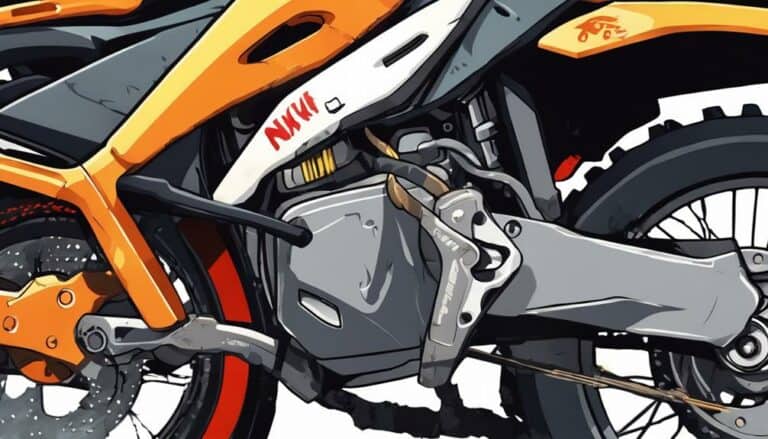Wondering if your dirt bike needs new brakes? You press on the brake lever, but something feels off. Maybe it's time to contemplate the condition of your brake system.
Pay attention to subtle changes in brake performance and unusual sounds. These could be indicators that your brakes are reaching the end of their lifespan.
Stay tuned to learn more about the telltale signs that your dirt bike might be due for some brake maintenance.
Key Takeaways
- Check for longer brake lever travel or diminished braking power.
- Listen for increased noise during braking.
- Inspect brake pad thickness regularly for wear indicators.
- Monitor brake performance and address any signs of wear promptly.
Signs of Worn Brake Pads
If you notice longer brake lever travel on your dirt bike, it may be a significant indication of worn brake pads. This issue can directly impact your front braking power, leading to decreased performance when stopping.
Signs to look out for include diminished braking power, which may result from glazing or contamination of the brake pads. Another common indicator is increased noise caused by metal-on-metal contact during braking, signaling that it's time to replace your brake pads.
Timely replacement of brake pads is essential for maintaining top safety levels while riding your dirt bike. By staying vigilant and recognizing these signs early on, you can make sure that your brakes are always in top condition, allowing for a safer and more enjoyable riding experience.
Remember to inspect your brake pads regularly to prevent any safety hazards on your dirt bike.
Checking Brake Pad Thickness
To determine if your dirt bike's brakes require replacement, assess the thickness of the brake pads using a caliper or a comparison method. For disc brake pads, they typically start at a thickness of 3-4mm. It is recommended to replace disc brake pads when the thickness wears down to less than 3mm. On the other hand, rim brake pads may have wear indicators such as grooves. Once these grooves are no longer visible, it is time to replace the rim brake pads. Regularly checking the brake pad thickness is important for maintaining top braking performance and ensuring your safety while riding. Below is a table summarizing the key points for checking brake pad thickness:
| Brake Type | Thickness Range | Replacement Indication |
|---|---|---|
| Disc Brake Pads | 3-4mm | Less than 3mm |
| Rim Brake Pads | Grooves visible | Grooves no longer visible |
Assessing Brake Performance
Assess brake performance by checking for signs of decreased braking power and listening for unusual noises that may indicate worn brake pads. Signs of decreased braking power can include longer brake lever travel, which suggests that the brake pads are worn and need replacing. Unusual noises, like metal-on-metal contact, are a red flag that your brake pads may be worn out.
To guarantee maximum safety and performance of your dirt bike, follow these steps:
- Visually inspect the brake pads for wear indicators such as grooves. If the grooves have disappeared, it's time to replace the brake pads.
- Monitor for any signs of glazing or contamination on the brake pads, as these issues can greatly reduce braking efficiency.
- Regularly assess the overall performance of your brakes to maintain peak safety standards and make sure your dirt bike stops effectively when needed.
Listening for Brake Noise
Listen for any unusual noises like scraping or grinding while braking on your dirt bike, as these sounds could indicate potential brake pad issues. Ignoring these sounds can lead to rotor damage, compromising your safety and best brake performance. Below is a table summarizing key points to help you understand the significance of brake noise and its impact on your dirt bike's safety:
| Brake Noise | Significance | Action Required |
|---|---|---|
| Scraping Noises | Indicates brake pads are worn and need replacement for best brake performance. | Replace brake pads promptly. |
| Grinding Noises | Suggests brake pads are severely worn, risking rotor damage and compromising brake safety. | Replace pads immediately. |
| Nails-on-Chalkboard Sound | Sign of brake pads reaching critical wear, necessitating urgent attention for safety. | Replace pads urgently. |
Regularly listening for brake noise and addressing issues promptly is essential for maintaining your dirt bike's brake safety and performance. Be proactive in identifying and resolving brake problems to guarantee a safe riding experience.
Inspecting Brake Fluid Levels
Wondering how to guarantee top brake performance on your dirt bike? Inspecting the brake fluid levels is essential in ensuring your safety on the trails. Here are some key points to keep in mind:
- Check the brake fluid reservoir for low levels: Low brake fluid levels can indicate potential brake issues that may impact your bike's performance.
- Importance of maintaining proper levels: Insufficient brake fluid can lead to air entering the brake system, resulting in spongy brakes that compromise your ability to stop effectively.
- Regular inspections are necessary: By routinely checking the brake fluid levels, you can catch any issues early on and address them promptly to maintain the best brake function.
Conclusion
So, next time you're tearing up the trails on your dirt bike, remember to listen for those screeching sounds and feel for those delayed stops.
Because who needs brakes anyway, right? Just kidding – make sure to keep an eye out for signs of worn brake pads and maintain your bike's braking system to guarantee a safe and thrilling ride every time.
Happy riding!

